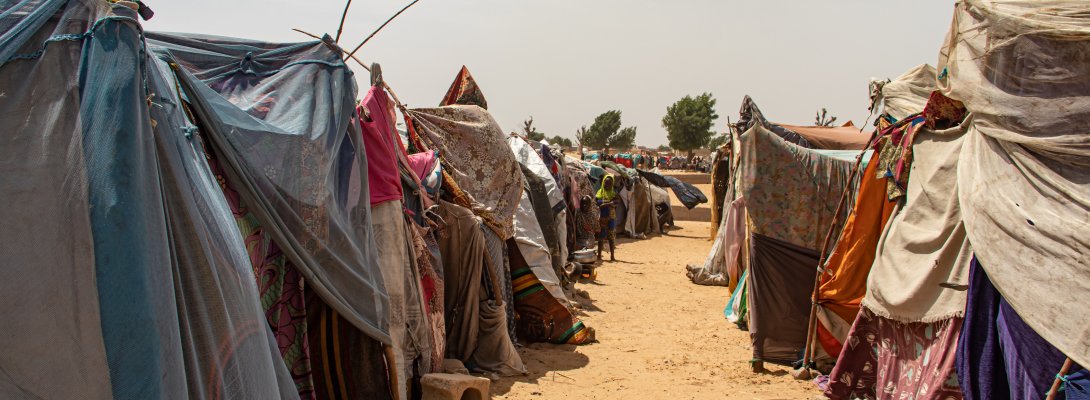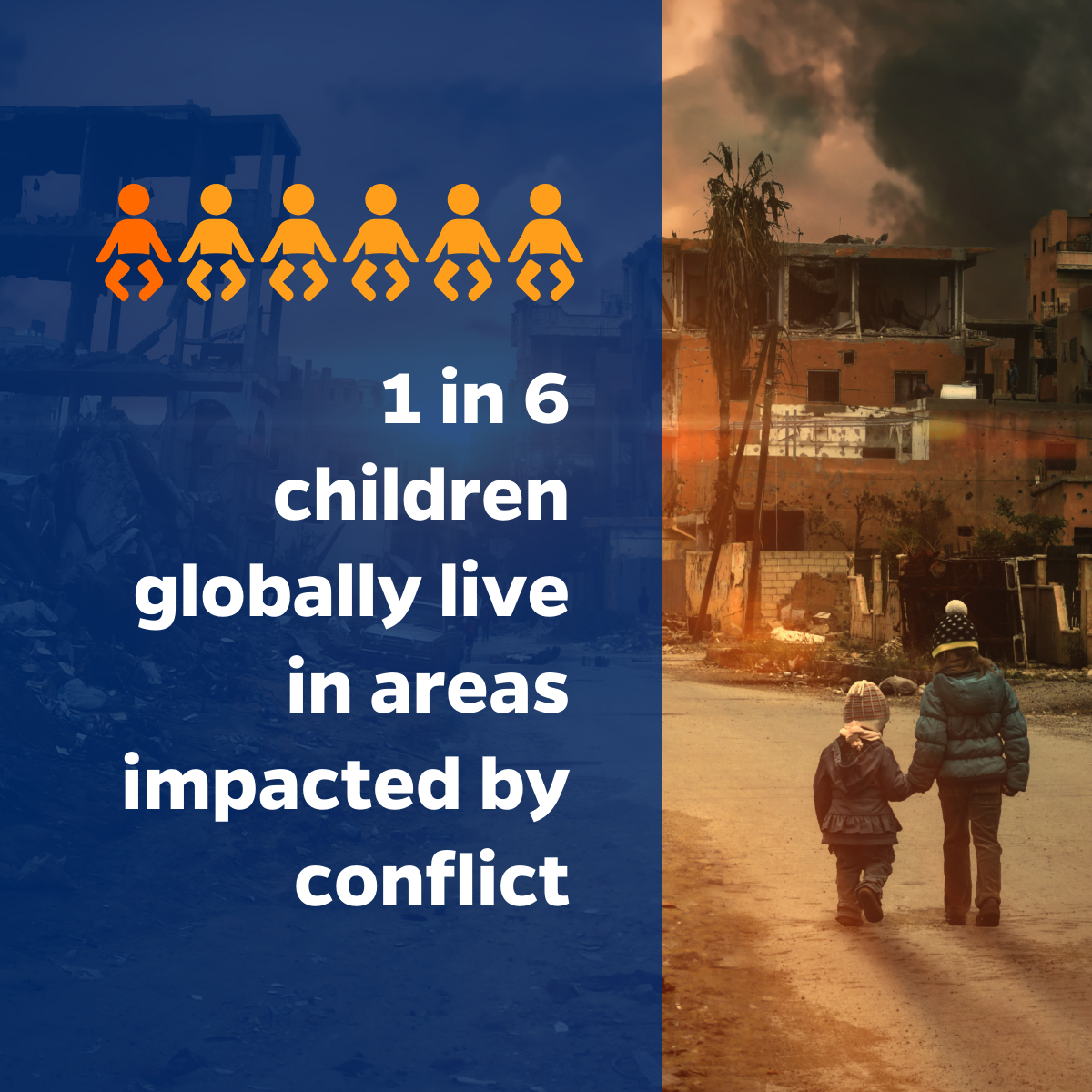
Table of Contents
- Background
- Strategies and Approaches for Immunization Programs in Conflict Settings
- Vaccination Coverage in Conflict Settings
- Key Takeaways
- Additional Resources
Background
In 2023, an estimated 473 million children – equal to 1 in 6 children globally – lived in an area impacted by conflict. Children affected by conflict and instability are not only vulnerable to violence, but also to disease—of the millions of un- and under-vaccinated children around the world, an estimated 40% live in countries affected by conflict. We may even be underestimating the scope of the problem, as population measurements are often unreliable in humanitarian settings and vaccination records may be lost as families are displaced.

In times of conflict or instability, even the most essential health services become difficult to provide and access. Vaccination clinics may be damaged or destroyed, and those that are still functioning may lack the infrastructure and supplies needed to properly store or administer vaccines. In 2023, there were at least 24 occasions in which health care workers were attacked while working on vaccination campaigns. These acts of violence may discourage not only the provision of care but also community members from seeking care at these facilities.
In addition to disruptions to critical health services like vaccination programs, children living in humanitarian settings are also likely to experience overcrowding, poor sanitation, and food shortages resulting in undernutrition, putting them at further risk of disease. An example was recently seen in Gaza, where vaccination coverage for the second dose of inactivated polio vaccine (IPV) dropped from 99% in 2022 to 90% in 2024 following heightened conflict. As Gaza’s water and sanitation systems were weakened by the conflict, even this modest decline in immunization coverage increased the risk of poliovirus transmission and led to the detection of circulating variant type 2 poliovirus in sewage samples in July 2024.
Fractured governance can also hamper immunization in conflict-affected settings, as poor collaboration and a lack of shared commitment may delay timely action and limit the effectiveness of vaccination efforts. All of these obstacles must be considered when designing and implementing immunization programs in fragile and conflict-affected settings to optimize uptake and protect vulnerable children from disease.
Strategies and Approaches for Immunization Programs in Conflict Settings
There is no one-size-fits-all approach to safely and efficiently deliver vaccines in fragile and conflict-affected settings, as contexts vary greatly. However, there are several strategies that should be considered and tailored as appropriate.
Alternative dosing schedules: When it is not possible to maintain a country’s routine immunization schedule, alternative dosing options may be an effective strategy to prevent disease outbreaks. For example, fractional doses of some vaccines—such as pneumococcal conjugate vaccine (PCV) and inactivated polio vaccine (IPV)—have been shown in certain settings to be a cost-effective approach to increase coverage when vaccine supply is insufficient. Although fractional dosing may reduce vaccine effectiveness, this drawback can potentially be mitigated through the use of campaigns targeting wider age ranges. Results from a study in Niger suggest that providing a single dose of PCV to an extended age range (1–9-year-olds) can effectively deliver herd protection and limit vaccine-type pneumococcus transmission in humanitarian settings, which often have high rates of pneumonia. These findings are reflected in preliminary guidance from WHO’s Strategic Advisory Group of Experts on Immunization (SAGE), which suggests that multi-age cohort campaigns delivering a single dose of PCV may be appropriate in humanitarian emergencies. This strategy would allow more children to be reached even with limited vaccine supply.
Alternative delivery strategies: Vaccine service delivery in humanitarian settings is situation- and context-dependent. Routine immunization channels should be used whenever possible, but when these methods are disrupted, alternative strategies should be considered. This could include mass vaccination campaigns, mobile outreach, or periodic intensification of routine immunization, among others. It may also be appropriate to establish vaccine posts at transit points, international border crossings, refugee camps, or social gathering spots like places of worship, which may provide additional opportunities to reach hard-to-access populations.
Integration with other humanitarian services: During emergency situations, integrating vaccination with other health and non-health services can be an efficient way to use limited resources and incentivize caregivers. For example, children in South Sudan experienced suboptimal vaccination rates during the country’s protracted civil war and resulting population displacement. Integrating immunization with outpatient nutrition services significantly increased vaccine uptake, as caregivers were more motivated to travel long distances for services when they could simultaneously access food for their children. This type of integration can leverage existing supply chains, transportation networks, and funding mechanisms to stretch resources and provide more services with less.
Engaging with new partners: Although national immunization programs are typically responsible for delivering vaccines, in times of conflict, it may be appropriate or even necessary to also leverage the expertise of humanitarian partners and civil society organizations. For example, Gavi’s Zero-Dose Immunization Programme (ZIP) brings together a wide range of organizations with experience navigating the complex challenges of conflict-affected settings. In the Sahel region, World Vision coordinates with many other organizations including the African Christian Health Association Platform (ACHAP), Food for the Hungry, CORE Group and other local partners to provide immunization across Burkina Faso, Cameroon, Central African Republic, Chad, Niger, Nigeria and Mali. In the Horn of Africa, the International Rescue Committee coordinates a network of partners including Acasus, Flowminder, IOM, ThinkPlace and local partners to reach vulnerable zero-dose populations in Ethiopia, Somalia, South Sudan and Sudan. Since 2022, these consortia successfully delivered 845,000 first doses and 479,000 last doses of vaccines to infants and children in challenging settings, often in communities where national immunization programs face barriers associated with conflict or crisis.
Ensuring safe access: In times of conflict, it may be difficult for vaccination efforts to safely reach communities. Service delivery strategies need to be continuously updated based on evolving threat levels, which will determine the timing and scope of activities that can be safely conducted. For example, polio campaigns have historically leveraged humanitarian pauses in conflict to safely administer vaccines. A recent mass vaccination campaign in Gaza effectively used this strategy to safely reach more than 600,000 children. Doses of novel oral polio vaccine type 2 (nOPV2) were provided at both fixed vaccination sites, including camps where displaced people were living, and by mobile teams visiting hard-to-reach areas. Without this humanitarian pause, a vaccination campaign of this scale would have been impossible.
Building community trust: It can be difficult to build and sustain trust in vaccines among vulnerable populations, such as refugee or migrant populations experiencing armed conflict and heightened social unrest, which can erode trust in authorities and healthcare workers. Community acceptance of vaccination is essential for a successful campaign, and a critical first step is to engage with and gain support from influential local religious and traditional leaders. Additionally, vaccination programs should be culturally tailored to these communities to promote trust and encourage uptake. For instance, Lebanon was an early adopter of inclusive policies for COVID-19 vaccination in 2021, ensuring that anyone living in the country—including its large number of refugees—would be able to access COVID-19 vaccines. However, the refugee and migrant community still faced barriers to immunization, including low levels of literacy and fears of being harassed or even detained while receiving vaccines. Culturally sensitive communication from trusted community members was critical to address these barriers and increase vaccine uptake.
Vaccination Coverage in Conflict Settings
Coverage data in fragile and conflict-affected situations, as defined by the World Bank, illustrate how conflict and fragility affect immunization. The VIEW-hub map below shows WHO/UNICEF estimates of national immunization coverage (WUENIC) and official country reported coverage for a second dose of measles-containing vaccine (MCV2) for countries defined as fragile and conflict-affected by the World Bank in FY25. While these are national-level indicators and immunization coverage can vary widely at the subnational level, the map illustrates that most conflict-affected and fragile countries have suboptimal MCV2 coverage. Of the 35 fragile or conflict-affected countries represented on the map, 19 (54%) have very low (less than 60%) MCV2 coverage. Most (15) of these are Gavi-eligible countries. Just one country on the map, Tuvalu, has very high (90-100%) MCV2 coverage, although this may not reflect subnational variation. A full MCV2 coverage dataset can be found on VIEW-hub. These countries report similar coverage levels for other life-saving vaccines, illustrating how conflict and fragility disrupt critical health services like vaccination and increase risk of disease.
Key Takeaways
A staggering number of children around the globe live in fragile or conflict-affected settings. The unique challenges experienced by these children contribute to insufficient vaccination coverage and increased risk of outbreaks. To overcome existing barriers, immunization efforts in these settings may need to consider innovative strategies such as alternative dosing schedules or delivery methods, integrating with other health services to increase reach, and building trust among vulnerable communities.
Additional Resources
Vaccination in Humanitarian Emergencies: Implementation Guide [WHO]
Vaccination in Acute Humanitarian Emergencies: A Framework for Decision Making [WHO]
Not Immune: Children in Conflict [Save the Children]
Summary of Key Evidence Related to Zero Dose in the Context of Humanitarian or Conflict Settings [IVAC/Gavi]
Equity in Crisis: Zero-Dose Children in Humanitarian Settings [IVAC/Gavi]